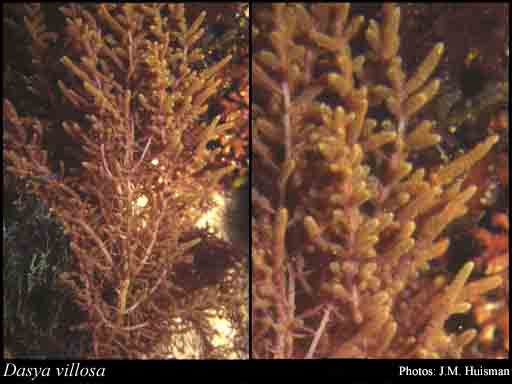- Reference
- London J.Bot. 433-434 (1844)
- Conservation Code
- Not threatened
- Naturalised Status
- Native to Western Australia
- Name Status
- Current

Scientific Description
Habit and structure. Thallus red-brown to very dark brown, occasionally light red, mucilaginous, 10–40 cm high, with 1–10 corticated axes 1–2(–3) mm in diameter. Main axes irregularly radially branched with many lateral axes, lightly to densely corticated, bearing pigmented, basally branched, slender, monosiphonous, attenuate filaments, often denuded below. Holdfast discoid, 2–5(–15) mm in diameter; epilithic and on solid substrates. Structure. Pericentral cells 5, cut off in circular sequence, at first lightly but below heavily corticated, remaining prominent in transverse sections of the mature axis; in older axes, some of the inner cortical cells may enlarge to the same size as the pericentral cells and protrude between them, thus appearing to have 6 or 7 pericentral cells, and coarse rhizoids later develop between the central cell and the pericentral cells which develop very thick walls; occasionally a space occurs in the centre of the axis when the central cell breaks down. Pseudolaterals one on each segment, 1–6(–8) mm long, attenuate, usually subdichotomous every (1–)2–3(–5) cells near their base, with the distal end of these cells often of a slightly greater diameter than the proximal end, 3–6(–7) sub dichotomies on any filament giving 8–20 ultimate branches, supra-basal cells 30–60 µm in diameter and L/D 1–2, cells after the last subdichotomy 19–25 µm in diameter and L/D 2.5–9, cells of ultimate filament 12–25 µm in diameter and L/D (3–)5–9. Adventitious monosiphonous filaments usually present, similar to pseudolaterals, arising from the cortical rhizoidal filaments and one, often two, from the basal cell of the pseudolateral; intercalary cell divisions absent. Lateral axes arising from the first branch of the one or two adventitious monosiphonous filaments arising on the basal cell of the pseudolateral, or later from the first branch of an adventitious monosiphonous filament. Rhodoplasts discoid, elongate and often reticulate in larger cells.
Reproduction. Gametophytes dioecious. Procarps borne spirally on successive segments of an adventitious polysiphonous axis, with 2 sterile group initials on the supporting cell but with a 3-celled rather than 4-celled carpogonial branch. Carposporophytes with a slight basal fusion cell and terminal clusters of apical and lateral clavate to lachrimiform carposporangia. Cystocarps sessile, appearing terminal or nearly so on a corticated axis, globose, 630–880 µm in diameter with a short wide neck 0.2–0.4 as long as the diameter of the cystocarp; pericarp 3–4 cells thick, outer cortical cells irregular. Spermatangial branches on the lower branches of the monosiphonous filaments, elongate, cylindrical or tapering, 200–850 µm long and 40–55 µm in diameter, 15–30 fertile segments long on a 1–3 celled monosiphonous stalk, with a (1–)4–15-celled attenuate apical filament. Tetrasporangial stichidia on the lower branches of the monosiphonous filaments, lanceoid to cylindrical but usually swollen where the spores are mature, on a 1–3-celled monosiphonous stalk, 300–1200 µm and 10–25 fertile segments long, 100–190 µm in diameter, with 6 pericentral cells all of which become fertile. Each tetrasporangium with 3(–4) undivided cover cells irregularly obloid in shape, palisade-like, (2–)3–5 times taller than broad in surface view, covering more than half of the sporangium of the same segment and the segment below, occasionally cutting off a smaller cell at the base when mature.
Distribution. Esperance, W. Aust., to Walkerville, Vic., and around Tas.
[After Parsons & Womersley in Womersley, Mar. Benthic Fl. Southern Australia IIIC: 427–430 (1998)]
Distribution
- IMCRA Regions
- Leeuwin-Naturaliste, WA South Coast.
- Local Government Areas (LGAs)
- Cockburn, Esperance, Rockingham.